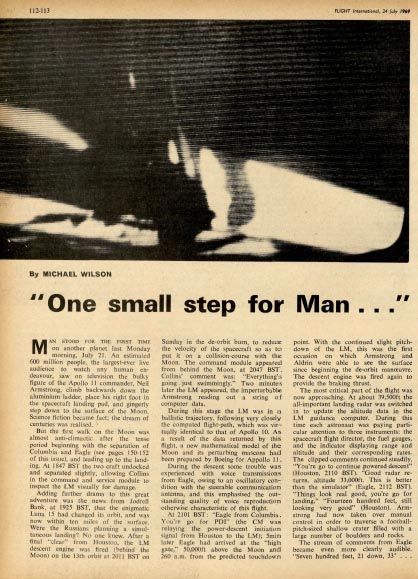The USA has won the space race its president had started nine years before. After the 1957 shock of the Soviet Union's Sputnik and the victories of Russia's Yuri Gagarin in April 1961 and Alexei Leonov's spacewalk in March 1965, finally it was the Americans that had won decisively the greater prize of reaching the Moon.
Not without its drama the descent was a tense period from the beginning with the separation of the command module Columbia and Eagle and leading up to the landing. At 1847 BST the two craft undocked and separated slightly, allowing Michael Collins in Columbia to inspect Eagle visually for any damage.
During the descent some trouble was experienced with voice transmissions from Eagle, owing to an oscillatory condition with the steerable communication antenna, and this emphasised the outstanding quality of voice reproduction otherwise characteristic of this flight.
On the way down the 1201 and 1202 alarms indicating computer problems raised the prospect of an abort but each time mission control gave a go command. And then in what should have been the final moments, the presence of a boulder field where Apollo 11 commander Neil Armstrong had expected to land, Eagle had to burn almost all of its fuel to reach past that and touchdown. Literally a last minute drama for what had already been a difficult journey.
Finally, after comms problems, computer alarms and boulder fields Armstrong had landed the Eagle at site two in the Sea of Tranquillity, four miles downrange of the predicted touchdown point and 37s later than predicted. But history was made and the USA had proved itself superior in the heavens.

Related content
See how Flight International reported the event at the time...
- Flight Image of the Day: LIFT OFF. We have a lift off. Lift off on Apollo 11
- Flight Blog: Apollo 11 40th anniversary - a collection of Flight International archive coverage of the Apollo programme and Flight Intrnational's latest issue celebrating the Moon landing 40 years on
- AirSpace: Apollo programme images
- Flightglobal's sister title: New Scientist - Apollo Special
- NASA: Hear the private conversations and view the transcript between Armstrong, Aldrin and Collins recorded aboard the Command Module Columbia and Lunar Module Eagle.
- NASA: History of onboard recorders on the Apollo spacecraft and full transcripts of all mission recordings
Source: FlightGlobal.com



















